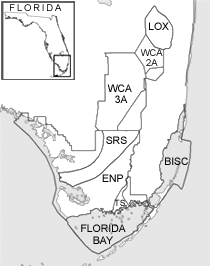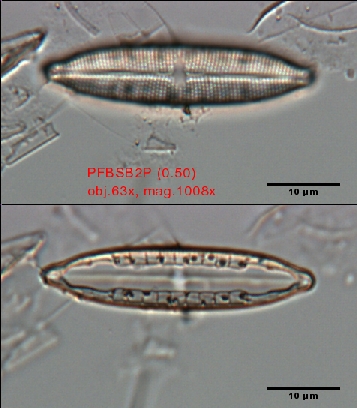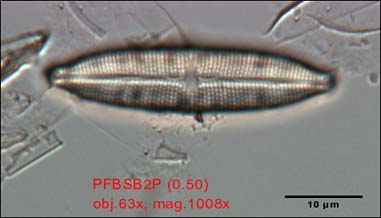Authority:
Twaites ex W. Smith
References:
Navarino, G. (1990). Observations on the frustule architecture of Mastogloia smithii, with particular reference to the valvocopulae and its integration with the valve. Diatom Research, 5 (2), 373-385; Podzorski A.C. (1985): "An illustrated and annotatet chack-list of diatoms from the Black River Waterways, St. Elizabet, Jamaica", p.29, Pl.5, fig. 21,22; Patric R. & Ch.W. Reimer (1966):"The diatoms of the United States", Vol.1,p.300, Pl.20, fig.8,9
Ecological Preference:
Fresh-Brackish
Description:
Valve elliptical to elliptical-lanceolate with short, protracted, subrostrate to subcapitate ends; axial area is narrow and linear; raphe is filiform, very slightly lateral about midway between the centre and valve ends, and can sometimes have a very slight bulge or lateral displacement (this feature is characteristic in most Mastogloia species, but is usually more prominent); distal ends are curving in the same direction at extreme ends of the valve, where very small thickenings resembling terminal nodules are apparent; central area is small, elliptical to nearly quadrangular; margins do not extend to chambers' edge; punctate striae are parallel or very slightly radiate (punctae 14-17 in 10µm); loculi (6-8 in 10µm) of intercalary band about equal in size, with inner margins slightly convex; length is 20-45µm, breadth is 8-14µm (Hustedt [1930] gives a length of up to 65µm, breadth up to 16µm); striae count is 18-19 in 10µm
Notes:
some specimens have higher length and breadth values than as described for type
Projects:
Southeast Florida Coastal Mangroves
Florida Bay Paleo Project
Dosing Project
CERP
Transect Project


